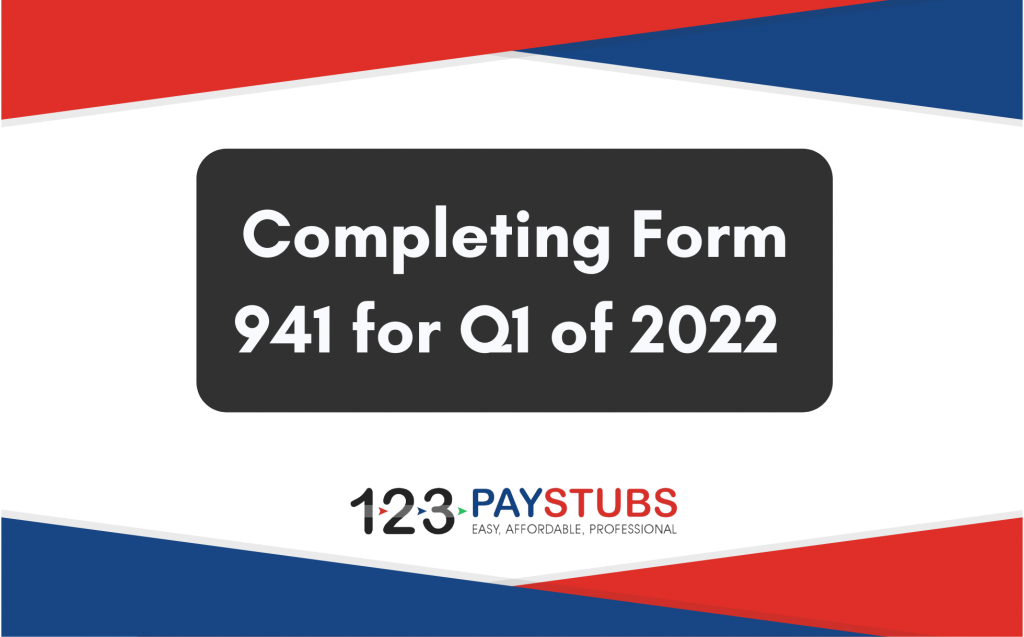Completing Form 941 for Q1 of 2022

It’s hard to believe quarter 1 of 2022 has already come and gone.
The May 02, quarter 1 Form 941 deadline will be here before you know it! Luckily, businesses can e-file their returns now with 123PayStubs!
Here’s an overview of Form 941 to help you get started:
What Does Form 941 Report?
If you pay wages subject to federal income tax withholding or social security and Medicare taxes, you must file Form 941 quarterly to report the following amount:
- Wages you’ve paid
- Tips your employees reported to you
- Federal income tax you withheld
- Both the employers and the employee share of social security and Medicare taxes
- Additional Medicare tax withheld from employees
- Current quarter’s adjustments to social security and Medicare taxes for fractions of cents, sick page, tips, and group-term life insurance
- Qualified small business payroll tax credit for increasing research activities
- Credit for qualified sick and family leave wages paid in 2022 for leave taken after March 31, 20202, and before October 1, 2021.
- Credit for COBRA premium assistance payments
You should not file Form 941 to report backup withholding or income tax withholding on nonpayroll payments such as pensions, annuities, and gambling winnings.
So, here’s how you will provide this information on your Form 941 return:
Provide your Business Information
At the top of Form 941, you will need to provide various business information. This information includes your employer identification number (EIN), business name, trade name (if applicable), and business address.
You will also need to check the appropriate box of the quarter for which you’re filing. It is important the quarter checked is the same as other forms attached with Form 941 such as Schedule B.
Complete each section of Form 941
IRS Form 941 consists of 5 different sections which all must be completed.
Section 1: Questions for the Quarter
For the first section, you will need to answer a variety of questions regarding the first quarter of 2022. You will need to provide information regarding your employees, wages paid to them, taxes withheld, tax credits, etc.
Section 2: Deposit Schedule and Tax Liability for the Quarter
In section 2, you will need to select your deposit schedule and provide your tax liability for each month in the quarter. You should enter your tax liabilities in the month that corresponds to the dates you paid wages to your employees, not the date payroll liabilities were accrued or deposits were made.
Monthly Schedule Depositor:
- If you reported $50,000 or less in taxes during the lookback period, you’re a monthly schedule depositor. The lookback period is the 4 consecutive quarters ending on June 30 of the prior year.
Semiweekly Schedule Depositor:
- If you reported more than $50,000 of taxes for the lookback period, you’re a semiweekly schedule depositor.
- If you are a semiweekly depositor, you must complete Schedule B (Form 941) and submit it with your Form 941.
Section 3: Discuss your business. If a question does not apply to your business, leave it blank.
In section 3, you will need to answer various questions about your business. These questions cover various topics such as if your business has closed, if you’re a seasonal employer, qualified health plan expenses, and qualified sick leave wages.
Section 4: Authorizing a third-party designee
In section 4, you must determine whether you will allow the IRS to speak with your business’s third-party designee.
If you want to allow an employee, a paid tax preparer, or another person to discuss your Form 941 with the IRS, check the “Yes” box in Part 4. You will also need to include your designee’s name, phone number, and five-digit personal identification number (PIN). The designee may choose any five numbers as his or her PIN.
Section 5: Signature
Once you’ve completed all of the information on Form 941, you must sign the form. The following people are authorized to sign the return:
- Sole proprietorship – the individual who owns the business
- Corporation (including LLCs treated as a corporation) – the president, vice president, or other principal officer duly authorized to sign
- Partnership (including LLCs treated as a partnership) – a responsible and duly authorized partner, member, or officer having knowledge of its affairs
- Single-member LLC treated as a disregarded entity for federal income tax purposes – the owner of the LLC or a principal officer fully authorized to sign
- Trust or estate – the fiduciary
Form 941 may also be signed by a duly authorized agent of the taxpayers if a valid power of attorney has been filed.
Submit Form 941
The IRS-preferred method of submitting Form 941 is e-filing. E-filing Form 941 is faster, easier, and more accurate than filing a paper return. E-filing provides faster processing and acknowledgments are returned in near real-time. You will also get more explicit error conditions and built-in accuracy checks with e-filing.
123PayStubs
Form 941 has many different sections and calculations, which leaves room for errors. Using an IRS-authorized e-file provider such as 123PayStubs will help you avoid major mistakes and transmit your return to the IRS securely. 123PayStubs also provides clients with resources to make their filing process simple and a helpful customer support team to assist them during filing. Create your free 123PayStubs account today to get started!

Leave a Comment